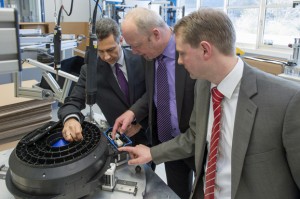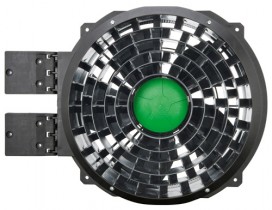When air cooler manufacturers design a new product, the process normally goes as follows. First the engineers develop the entire unit, then they look for a fan with the right operating point. A project by GEA Küba GmbH shows that it is worth rethinking this process, after they developed their new air cooler together with ebm-papst right from the start. “As our product had already been on the market for a few years, we planned a complete redesign”, explains Steven Duncan, Director of Technology, Research and Development at GEA Küba. “We brought ebm-papst on board from day one so we could perfectly attune all the components to each other.”
At the start of the project, Duncan and his colleagues from R & D got together with Manager of Service and Product Management Mathias Lich and Thomas Heli, Head of Development at ebm-papst, to put their heads together. The team began by determining what the requirements were for the air cooler. These have become more and more demanding in the past few years, as today’s customers expect efficient systems with high air throw that can also be easily cleaned and maintained. Air coolers are often used in food refrigeration, meaning additional strict hygiene requirements for the devices used. In order to meet all these expectations, the teams from ebm-papst and GEA Küba prioritised improving the air conduction in the cold store. “We use so-called air-guiding systems to increase the air throw”, explains Thomas Heli. “They reduce the swirl from the stream of cooling air coming from the air cooler. This prevents the air flow from bursting and the cooling air reaches every last corner of a room.”
In the EC version, the energy consumption is 30 percent lower compared to AC technology. In some cases even up to 67 percent.
Steven Duncan, GEA Küba
This task was previously fulfilled adequately enough by honeycomb-like air-guiding systems, but efficiency was low. The reason for this was that although the previous component guided the air correctly, it also caused a high loss of pressure, which led to a reduced air flow. This meant that the power of the fan was not being implemented as well as it could. The solution that the partners found is an air-guiding system newly developed by ebm-papst, which directs the air without significantly reducing the air flow. This helped the air cooler to double the air throw compared to the solution without an air-guiding system. To achieve this, the project teams of the partner companies, both in technical and commercial areas, worked together like a well-oiled machine to implement new ideas quickly and easily.
Efficiency gets another significant boost when the air cooler is fitted with an AxiCool EC fan. “In this version, the energy consumption is 30 percent lower compared to AC technology,” explains Steven Duncan. “In some cases even up to 67 percent.” The EC motor version offers the additional advantage of conveying much less heat into the cold store and can be easily controlled from 0 to 10 volts according to requirements via a signal.
An important factor for customers is being able to clean and maintain the air cooler easily.
Mathias Lich, GEA Küba
But when it comes to actually using the fans, efficiency and strong air flow are not everything. “Another important factor for customers is being able to clean and maintain the air cooler easily,” says Matthias Lich. That is why all air conduction components in the air-guiding system are made from high-quality plastic. As well as opening up new possibilities in design, these materials also offer further advantages. Mathias Lich: “These materials help us achieve very smooth surfaces that are not vulnerable to corrosion. This is especially important in the food industry. The plastics are also less sensitive to aggressive cleaning products.”

Exclusively for GEA Küba, ebm-papst integrated the terminal box for connecting the AxiCool fan into the hinge.
Cleaning is also made easier due to the fact that the wall ring is mounted on a hinge, meaning it can be folded out to the side when cleaning the heat exchanger. Exclusively for GEA Küba, ebm-papst integrated the terminal box for connecting the AxiCool fan into the hinge, saving space and keeping the design of the air cooler simple. At a team meeting, Lich, Duncan and Heli noticed another advantage provided by the new plastic wall ring: it is hollow and designed in a way that allows a heating tape to be integrated. “By specifically heating the inner side of the wall ring, we are able to much more efficiently prevent the formation of so-called ice bridges that cause the fan blades to freeze up”, says Mathias Lich. As the heating tape is no longer mounted on an open wall ring from outside as was previously the case, it now only works where it is really needed, thus making the wall ring heating up to 80 percent more efficient.
Our companies share the same understanding of quality and cooperative partnership.
Thomas Heli, ebm-papst
The new series of air coolers has been on the market for just over a year and the feedback from customers has been consistently positive. The project partners, too, are happy with the results. Thomas Heli: “Thanks to the excellent relationship of trust, we in the entire interdisciplinary team were able to work with a high degree of motivation. It is also a big help that our companies share the same understanding of quality and cooperative partnership.” Mathias Lich adds: “After this extremely positive experience, we will continue to work on developments with ebm-papst in the future.”
AxiCool
 AxiCool fans set a new market standard for evaporators and cooling units with the perfect interaction of individual components. The compact axial fans impress with simple handling, top efficiency in every regard and careful resource preservation. Convenient service, ease of operation and excellent air throw round off the positive features. As the fan can be mounted with just four screws, they are “plug and play” solutions in the truest sense of the phrase.
AxiCool fans set a new market standard for evaporators and cooling units with the perfect interaction of individual components. The compact axial fans impress with simple handling, top efficiency in every regard and careful resource preservation. Convenient service, ease of operation and excellent air throw round off the positive features. As the fan can be mounted with just four screws, they are “plug and play” solutions in the truest sense of the phrase.

Leave a comment